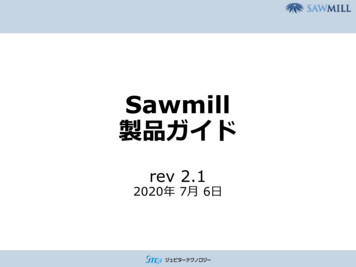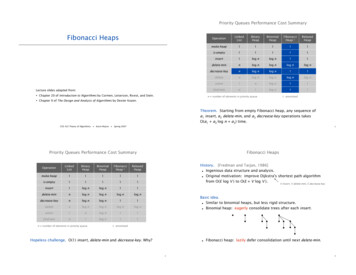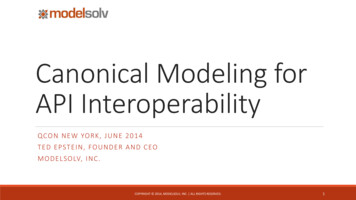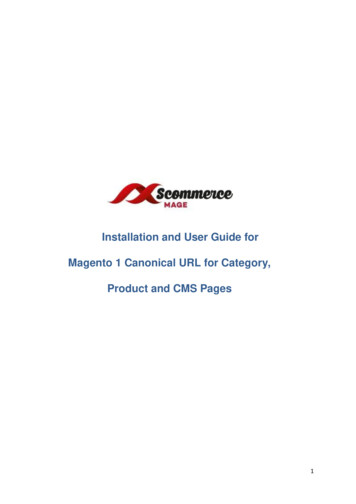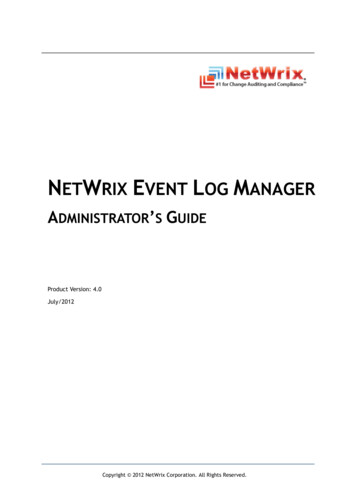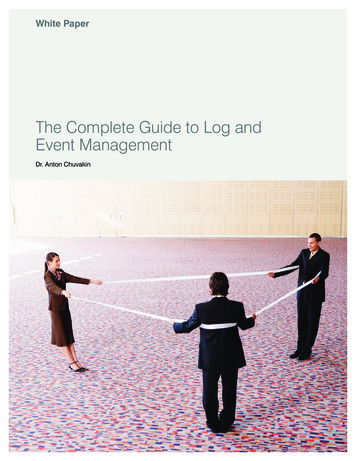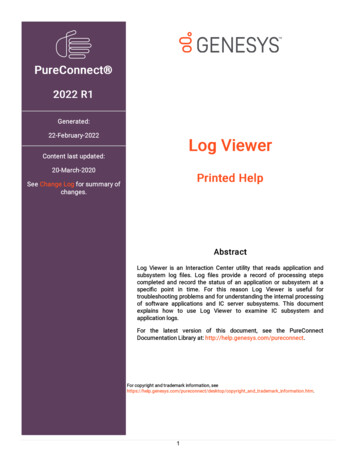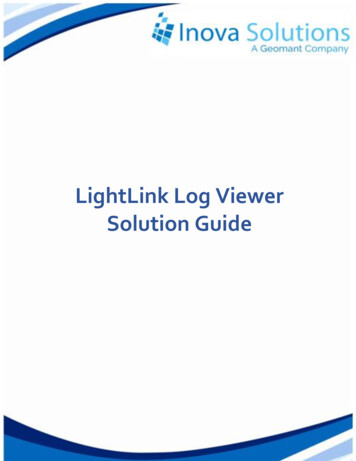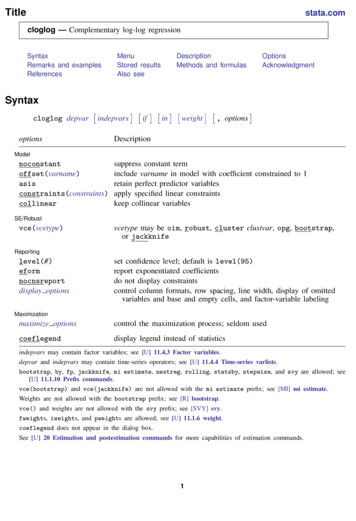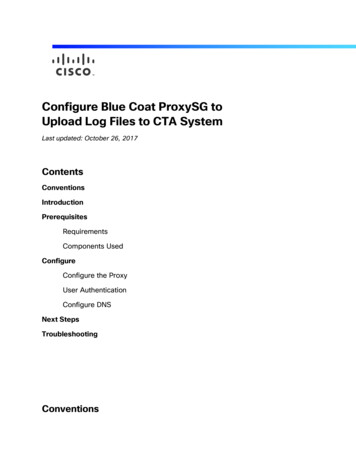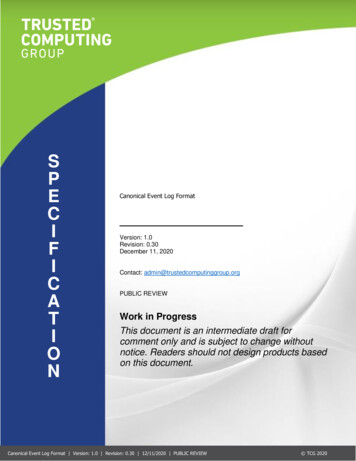
Transcription
SPECIFICATIONCanonical Event Log FormatVersion: 1.0Revision: 0.30December 11, 2020Contact: admin@trustedcomputinggroup.orgPUBLIC REVIEWWork in ProgressThis document is an intermediate draft forcomment only and is subject to change withoutnotice. Readers should not design products basedon this document.Canonical Event Log Format Version: 1.0 Revision: 0.30 12/11/2020 PUBLIC REVIEW TCG 2020
Canonical Event Log FormatDISCLAIMERS, NOTICES, AND LICENSE TERMSTHIS SPECIFICATION IS PROVIDED “AS IS” WITH NO WARRANTIES WHATSOEVER, INCLUDING ANYWARRANTY OF MERCHANTABILITY, NONINFRINGEMENT, FITNESS FOR ANY PARTICULAR PURPOSE, ORANY WARRANTY OTHERWISE ARISING OUT OF ANY PROPOSAL, SPECIFICATION OR SAMPLE.Without limitation, TCG disclaims all liability, including liability for infringement of any proprietary rights, relating to useof information in this specification and to the implementation of this specification, and TCG disclaims all liability forcost of procurement of substitute goods or services, lost profits, loss of use, loss of data or any incidental,consequential, direct, indirect, or special damages, whether under contract, tort, warranty or otherwise, arising in anyway out of use or reliance upon this specification or any information herein.This document is copyrighted by Trusted Computing Group (TCG), and no license, express or implied, is grantedherein other than as follows: You may not copy or reproduce the document or distribute it to others without writtenpermission from TCG, except that you may freely do so for the purposes of (a) examining or implementing TCGspecifications or (b) developing, testing, or promoting information technology standards and best practices, so longas you distribute the document with these disclaimers, notices, and license terms.Contact the Trusted Computing Group at www.trustedcomputinggroup.org for information on specification licensingthrough membership agreements.Any marks and brands contained herein are the property of their respective owners.Canonical Event Log Format Version: 1.0 Revision: 0.30 12/11/2020 PUBLIC REVIEWPage 1 TCG 2020
Canonical Event Log FormatCHANGE HISTORYREVISIONDATEDESCRIPTIONREVISIONDATE DESCRIPTION1.00/.10April 3, 2018 Initial Release of Draft Version 1.00 Revision 0.10.1.00/.11June 10, 2018 1.00/.12Oct 16, 2018 1.00/.13July 16, 2019 To add new rows to the table, hit the TAB key from this lastcell.Change document to an Information Model. Move originalinformation into back of document for future reference.Merged comments and changed from difference files1.00/.14July 17, 2019 1.00/.15September 03.2019 Merged in edits and comments from 2019-06-13 MembersMeeting (comments merged in are tagged with 2019-06-13MM)Incorporated comments from previous WG Reviews1.00/.16December 12, 2019 Introduce table base data model1.00/.17April 21, 2020 1.00/.18April 29, 2020 Incorporate TLV as an available encoding, use termsconsistently.Completed and tested IMA-TLV example1.00/19May 6, 2020 1.00/20May 20, 2020 Added IMA LEGACY example, and moved examples toappendix A.Clarified NV index and State Transition fields1.00/21June 3, 2020 Added PCCLIENT STD example1.00/22June 10, 2020 Added CEL MGT and PCCLIENT NG1.00/23July 22, 2020 Added CEL-CBOR CDDL1.00/24July 29, 2020 Minor cleanups for consistency1.00/25October 7, 2020 Final cleanup1.00/26October 28, 2020 Reorganize for clarity and address all comments1.00/27October 28, 2020 Added algorithm reference1.00/28November 17, 2020 1.00/29December 9, 2020 Usage of term Extend and Quote consistentUpdate references to references numbersCopy for public review1.00/30December 11,2020 Minor edits prior to public review Canonical Event Log Format Version: 1.0 Revision: 0.30 12/11/2020 PUBLIC REVIEWPage 2 TCG 2020
Canonical Event Log FormatContentsDISCLAIMERS, NOTICES, AND LICENSE TERMS . 1CHANGE HISTORY . 21Background and Scope . 51.1 Background . 51.2 Scope . 52Document Style . 72.1 Key Words . 72.2 Statement Type . 73References and Terms . 83.1 References . 83.2 Terms . 83.2.1 Native Event Log Record (NELR) . 83.2.2 Canonical Event Log (CEL) . 83.2.3 Canonical Event Log Record (CELR) . 83.2.4 Canonical Event Log Information Model (CEL-IM) . 83.2.5 Canonical Event Log Encoding (CEL-EN) . 83.2.6 Event Log Critical Data (ELCD) . 83.2.7 Event Log Informative Data (ELID) . 94Canonical Event Log Information Model (CEL-IM). 104.1 Canonical Event Log (CEL) Definition . 104.2 Canonical Event Log Record (CELR) Definition . 104.2.1 CELR General Requirements . 104.2.2 Record Number Field . 104.2.3 Record PCR or NV Index Field . 104.2.4 Record Digest Field . 104.2.5 Record Event Content Field . 114.3 CELR data type definitions . 114.4 CEL Management Event Types . 115Canonical Event Log Encodings (CEL-EN). 145.1 Canonical Event Log Record Encoding – TLV (CEL-TLV) . 145.1.1 CEL RECNUM TLV . 155.1.2 CEL PCR NVindex TLV . 155.1.3 CEL DIGESTS TLV . 155.1.4 CEL CONTENT TLV . 165.1.5 IMA TLV Content Layer . 16Canonical Event Log Format Version: 1.0 Revision: 0.30 12/11/2020 PUBLIC REVIEWPage 3 TCG 2020
Canonical Event Log Format5.1.6 IMA TEMPLATE Content Layer . 185.1.7 PCCLIENT STD Content Layer. 205.1.8 CEL MGT Content Layer . 235.2 Canonical Event Log Encoding - Binary (CEL-CBOR) . 245.2.1 Canonical Event Log Record Encoding for JSON (CEL-JSON) . 245.2.2 CEL-CBOR Encoding Layer CDDL Specification. 246Defined types for all examples. . 29Canonical Event Log Format Version: 1.0 Revision: 0.30 12/11/2020 PUBLIC REVIEWPage 4 TCG 2020
Canonical Event Log Format1 Background and ScopeAttestation is the process of reporting a platform’s operational state. During boot, and optionally during continuedoperation, the platform executes components that may impact the trustworthiness of its operational state. To supportAttestation, the identity or state of each of these components is recorded such that those identities or states can bereported as authentic (i.e., they are from the expected platform and are integrity protected). This process is calledMeasurement. When using the TPM [1], the measurement process uses the TPM’s Extend1 operation. DICE [6] hassimilar operations2.A Measurement at a minimum performs an Event operation. This results in the Attestation of an accumulated platformstate at a particular point, but there is no visibility into the individual components comprising that point or state. Aparticular Measurement, may, therefore, record information about the component being measured. This type ofmeasurement is called an Event Log Record. The collection of the Event Log Records is an Event Log.The Extend operation provides evidence of the integrity of a measurement. The Event Log may be stored in insecurelocations. Authenticity of the Event Log is performed using a Quote operation3.1.1 BackgroundDifferent platform classes and even different processes with a single platform class may create Event Log Records informats specific and optimized to a particular environment. The PC Client, for example, uses a format [2] defined byTCG that is optimized for that platform’s firmware. Rather than put serialization information within each record, thisEvent Log Record format is optimized for space by requiring Event Log Records to be sequential in memory in orderto preserve the sequence of the measurements performed using the Extend operations. This is acceptable forfirmware because there are a finite number of measurements during the boot process. Once the platform’s OperatingSystem starts, the firmware stops execution and ceases to create measurements. These limited number of Event LogRecords can be captured leaving storage, transmission, and serialization, if needed, to higher later layers.Even within the same platform class, when the firmware completes and stops performing measurements, theOperating System may measure runtime events such as the execution of applications. These Event Log Records maybe in historical formats or formats more optimized for the run-time environment. Another significant difference from afirmware measurement is that the Operating System measurement may be continuous, creating more Event LogRecords than can be efficiently stored on the platform. The Event Log Records may, therefore, need to be exportedfrom the originating platform to an external storage location. As there is no reliance on the transmission and storageto maintain the Event Log Record sequence, each Event Log Record must contain a unique sequential index number.Further, embedding sequence information within each Event Log Record enables tracking of Event Log Records thathave been moved or deleted from their originating platform, and enables efficient transmission from host to host.1.2 ScopeThis specification for the Canonical Event Log covers three layers: a single top-level Information Model, possiblymultiple encoding layers, and multiple content layers. This specification provides a single information model forrepresenting a Canonical Event Log Record that can encapsulate native Event Log Records from various sources.This specification also provides a simple Type-Length-Value (TLV) encoding layer and a Concise Binary ObjectRepresentation (CBOR) encoding layer. This specification covers TLV and CBOR encapsulation of some contentlayers, including CEL Management, PCCLIENT [2] and IMA [5] content. While a content layer implementation may1Several TPM commands support the Extend operation. Examples are TPM2 PCR Extend, TPM2 PCR Event, theTPM2 hash * sequence, and even the TPM 1.2 TPM Extend. For the purpose of this specification, these are equivalentand are collectively called the Extend operation (Note the use of capitalization to distinguish this specific operation.)2DICE performs a similar operation to Extend by performing a series of hashes over its boot components. This operationis also included in the general term Extend used in this specification.3This specification will use the term Quote operation as a general term for the proof of an Attestation such as a series ofmeasurements. A Quote may be performed using the TPM2 PCR Quote command but other methods are available suchas a TPM2 PCR Read within an Audit Session. Unless otherwise stated, this specification will use the term Quote as ageneral operation to mean the general operation of proving a series of measurements that may use a key restricted byTPM Policies.Canonical Event Log Format Version: 1.0 Revision: 0.30 12/11/2020 PUBLIC REVIEWPage 5 TCG 2020
Canonical Event Log Formatchoose to create an exact binary mapping to this information model as its native Event Log Record, otherimplementations may choose to bind this information model to other formats, such as TLV or CBOR.As an information model, this specification’s normative statements pertain to the type of information which must beincluded in any encoding layer format. This specification also normatively states the TLV encoding layer and CBORencoding layers which may be used.Canonical Event Log Format Version: 1.0 Revision: 0.30 12/11/2020 PUBLIC REVIEWPage 6 TCG 2020
Canonical Event Log Format2 Document Style2.1 Key WordsThe key words “MUST,” “MUST NOT,” “REQUIRED,” “SHALL,” “SHALL NOT,” “SHOULD,” “SHOULD NOT,”“RECOMMENDED,” “MAY,” and “OPTIONAL” in this document’s normative statements are to be interpreted asdescribed in RFC-2119, Key words for use in RFCs to Indicate Requirement Levels.2.2 Statement TypePlease note an important distinction between different sections of text throughout this document. There are twodistinctive kinds of text: informative comment and normative statements. Because most of the text in this specificationwill be of the kind normative statements, the authors have informally defined it as the default and, as such, havespecifically called out text of the kind informative comment. They have done this by flagging the beginning and end ofeach informative comment and highlighting its text in gray. This means that unless text is specifically marked as ofthe kind informative comment, it can be considered a kind of normative statements.EXAMPLE: Start of informative commentThis is the first paragraph of 1–n paragraphs containing text of the kind informative comment .This is the second paragraph of text of the kind informative comment .This is the nth paragraph of text of the kind informative comment .To understand the TCG specification the user must read the specification. (This use of MUST does not require anyaction).End of informative commentCanonical Event Log Format Version: 1.0 Revision: 0.30 12/11/2020 PUBLIC REVIEWPage 7 TCG 2020
Canonical Event Log Format3 References and Terms3.1 References[1] “TPM 2.0 Library Specification”; Family “2.0” Level 00 Revision 01.38 September 29, m-library-specification/[2] “TCG PC Client Platform Firmware Profile Specification”; Family “2.0” Level 00 Revision 1.04 June 3, cation/[3] “TCG Algorithm Registry, Family “2.0”, Level 00 Revision 01.24 January 25, -algorithm-registry/[4] “TCG PC Client Platform Firmware Integrity Measurement Specification”; Version 0.15 March 31, uploads/TCG PC Client FIM v1 r40 02dec2020.pdf[5] Integrity Measurement Architecture (IMA), Part of the official Linux Kernel, http://kernel.org[6] Dice Architecture: -architectures/3.2 TermsStart of informative comment3.2.1 Native Event Log Record (NELR)This is an Event Log formatted by the native environment that produced the measurement. This may be a TCGstandard (e.g., as defined by the PC Client Platform Specification [2]) or may be a de-facto standard, such asproduced by bootloaders and operating systems.3.2.2 Canonical Event Log (CEL)The CEL consists of one or more Canonical Event Log Records.3.2.3 Canonical Event Log Record (CELR)An Event Log Record, irrespective of the data representation format, which meets the CEL mandatory requirements.A complete record containing required information for the Verifier to verify the integrity of the information in theEvent Log Record and the information needed to assess a platform’s trustworthiness. A reference to an Event LogRecord does not imply any particular format. For example, a PC Client’s Event Log [2] is a complete Event LogRecord because it contains the information needed to verify the Event Log information, including the PCR numberand the implicit sequence number, (that is indicated by the record’s position within the allocated memory). A CELRalso contains the critical data needed by the Verifier to determine a platform’s trustworthiness3.2.4 Canonical Event Log Information Model (CEL-IM)A specification of the data that must be contained in a CELR, irrespective of Encoding.3.2.5 Canonical Event Log Encoding (CEL-EN)A specific data format to meet to the CEL requirements. This may be TLV, CBOR, or a simple binary format.3.2.6 Event Log Critical Data (ELCD)This is information required by the Verifier to either verify the integrity of the Event Log Record or information usedby the Verifier to determine a platform’s trustworthiness. A sequence number is an example of Critical Datarequired to verify to the integrity of the Event Log Record. The Verifier must process the series of Event LogRecords in the order they were measured. Another example of ELCD is the PCR number.Canonical Event Log Format Version: 1.0 Revision: 0.30 12/11/2020 PUBLIC REVIEWPage 8 TCG 2020
Canonical Event Log Format3.2.7 Event Log Informative Data (ELID)This is information that is helpful to the Verifier but is not measured. For example, while the actual hash of afirmware component that is Extended is Event Log Critical Data, the Event Log Record may contain otherinformation such as a string representing firmware’s source and version information that may assist in verification. Inthis example, if a Platform has had several firmware updates, the Verifier may use this Event Log Informative Datato lookup (or request) the expected measured value.End of informative commentCanonical Event Log Format Version: 1.0 Revision: 0.30 12/11/2020 PUBLIC REVIEWPage 9 TCG 2020
Canonical Event Log Format4 Canonical Event Log Information Model (CEL-IM)4.1 Canonical Event Log (CEL) DefinitionA Canonical Event Log SHALL consist of a list of Canonical Event Log Records (CELR).4.2 Canonical Event Log Record (CELR) DefinitionA Canonical Event Log record SHALL consist of four fields: a record number, a PCR or NV Index number, a digest,and a content field.4.2.1 CELR General Requirements4.2.1.1 Maintenance of the Measurement IntegrityA Verifier MUST be able to verify the integrity of all Event Log Critical Data (ELCD) whether the ELCD wasgenerated directly into CELR or whether a utility transformed a Native Event Log Record (NELR) into a CELR.4.2.1.2 Event Log Critical DataA Canonical Event Log Record (CELR) MUST contain all information from the original entity that created themeasurement. If the CELR is created by transforming a Native Event Log Record (NELR), the transformation MUSTallow the Verifier to verify the integrity of the resulting CELR using information from the TPM Quote Operation. Notethat the conversion from NELR to CELR may produce more information in the CELR than was in the original NELR.For example, the CELR may contain an explicit sequence number when the NELR contained only an implicit one.4.2.2 Record Number FieldThis identifies the sequence of the CELR within a set of measurements. The Value Element is the sequence numberrepresented as an unsigned integer. This field is referred to as the RECNUM.The RECNUM value MUST:1. Start at zero at TPM2 Startup (CLEAR).2. Monotonically increment with each measurement.3. Be maintained separately per index, in the case of a log with records for multiple different PCR or NVindices. (For example, IMA is authoritative only over its PCR (i.e. 10) and need not coordinate RECNUMwith other PCRs.)4. Increment regardless of whether the Event is measurement or unmeasured.4.2.3 Record PCR or NV Index FieldThis field indicates which PCR or NV Index was affected by a measurement. As a measurement can Extend onlyone PCR or NV index, there is no rationale for this field being represented as a bitmap (i.e.,TPMS PCR SELECTION). The field, therefore, MUST be the integer representation of the PCR or NV index.4.2.4 Record Digest FieldThis field contains the list of the digest values Extended. The Extend method varies with TPM command, so there isno uniform meaning of TPM Extend in this instance, and separate descriptions are unavoidable. If using theTPM2 PCR Extend command, this field is the data sent to the TPM (i.e., not the resulting value of the PCR afterthe TPM2 PCR Extend command completes). If using the TPM2 PCR Event command, this field contains thedigest structure returned by the TPM2 PCR Event command (that contains the digest(s) submitted to each PCRbank as the internal Extend operation). This field SHALL contain the information from the TPML DIGEST VALUESused in the Extend operation. (Exactly how this information is encoded will be described in the selected encodinglayer).Canonical Event Log Format Version: 1.0 Revision: 0.30 12/11/2020 PUBLIC REVIEWPage 10 TCG 2020
Canonical Event Log Format4.2.5 Record Event Content FieldThis field contains both the Event Log Critical Data (ELCD) and Event Log Informative Data (ELID) as defined by theContent Type Custodian. This specification (CEL) defines the values identifying the Content Type Custodian but theinformation within the Event Content Value field is entirely defined by the Content Type Custodian.Note that there are one or more Content Types assigned to the CEL. These are typically management Events ordetermined to be common across all Content Type domains, so they are defined as part of this specification.The Content Type Custodian defines what components of the Event Content are hashed to create the Extend value.These components are likely the entire set of Event Log Critical Data (ELCD), but Event Log Informative Data(ELID) MAY be included.If multiple PCR Banks are Extended, the same method MUST be used for deriving each PCR Bank’s digest.4.3 CELR data type definitionsThe data type in Table 1 defines the CELR data type TPMS EVENT. If a numeric representation is required for thespecific encoding (such as binary or TLV) then the values from the column “value” SHALL be used. (Again, thisInformation Model specifies the data content, not the encoded format.)Table 1 TPMS EVENTDATA TYPEUnsigned IntegerUnsigned IntegerFIELD NAMErecnumpcrVALUE01DESCRIPTIONUnique Record NumberPCR indexUnsigned Integernv index2NV IndexTPML DIGEST VALUESdigests3Digests ExtendedTPMU EVENTCONTENTcontentCONTENT TYPE The event data for this CELRNote that TPML DIGEST VALUES is a complex structure, including variable length arrays of structures. Thisinformation model specifies only that the contents and ordinals from TPML DIGEST VALUES be used and doesnot specify how they are encoded. Section 5.3 shows how this may be encoded using TLV.The enumeration in Table 2 defines the supported content types. If a numeric representation is required for thespecific encoding (such as binary or TLV) then the values from the column “value” SHALL be used.Table 2 CONTENT TYPENAMECELPCCLIENT STDIMA TEMPLATEIMA TLVVALUE4578DESCRIPTIONCEL management; Content managed by TCG / CELPC Client WG defined encapsulated structureLinux-IMA TEMPLATE formatLinux-IMA TLV format4.4 CEL Management Event TypesA CEL Management Event consists of a type and depending on the type it might contain additional information.Some of these Events are measured into a PCR whilst others are not. This is denoted accordingly in each part ofsection 4.4.1.Table 3 defines the content of a CEL Management Event TPMS EVENT CELMGT.Table 3 TPMS EVENT CELMGTTYPEFIELDCanonical Event Log Format Version: 1.0 Revision: 0.30 12/11/2020 PUBLIC REVIEWDESCRIPTIONPage 11 TCG 2020
Canonical Event Log FormatTPMI CELMGTTYPETPMU CELMGTtypedataThe type of CEL eventThe data of this CEL eventThe VALUE column in Table 4 defines the types of CEL Management Events TPMI CELMGTTYPE.Table 4 TPMI CELMGTTYPENAMEVALUECEL VERSION1FIRMWARE END2CEL TIMESTAMP80STATE TRANS81DESCRIPTIONIdentifies the CEL specification version(Not measured into PCR)End of firmware events(Not measured into PCR)Provides a timestamp(Measured into PCR)Identifies a platform state transition (e.g.hibernation)(Measured into PCR)Table 5 defines the CEL Management Event content TPMU CELMGT. The referenced types stem from the TPMlibrary specification part 2 (TPMS EMPTY) or are defined in the following sections.Table 5 TPMU CELMGTTYPETPMS CEL VERSIONFIELDcel versionSELECTORCEL VERSIONTPMS EMPTYfirmware endFIRMWARE ENDUINT64cel timestampCEL TIMESTAMPTPMS STATE TRANSstate transSTATE TRANSDESCRIPTIONIdentifies the CEL specification versionEnd of firmware eventsThis event contains not further data, thusTPMS EMPTY is matched for the union.Provides a timestamp as UTC time, in Linuxseconds from the epoch format.Identifies a platform state transition4.4.1.1 CEL VersionThe Event Content Value Element identifies the specification version this Event Log adheres to. Table 6 defines thecorresponding data types for TPMS CEL VERSION.Table 6 TPMS CEL ajor version (currently 1)Minor version (currently 0)This Event SHALL NOT be measured, but is included for informational purposes.4.4.1.2 Firmware EndThis Event Content Value Element marks the end of the device’s firmware boot phase and the start of the OS /operational phase. It does not contain any further information.4.4.1.3 CEL TimestampThis Event Content Value Element contains a timestamp that was Extended.Canonical Event Log Format Version: 1.0 Revision: 0.30 12/11/2020 PUBLIC REVIEWPage 12 TCG 2020
Canonical Event Log FormatThe data SHALL encoded as UINT64 representing the milliseconds since time-origin (value 0) according to theCoordinated Universal Time (UTC).4.4.1.4 State TransThis Event Content Value Element contains the device’s state transition. For example, devices that enter sleepstates may want to provide a measured event indicating this transition. Table 7 defines the structure of event datafor this type of CEL Management Event TPMS STATE TRANS.Table 7 TPMS STATE TRANSNAMESuspendHibernateKexecFIELD012Canonical Event Log Format Version: 1.0 Revision: 0.30 12/11/2020 PUBLIC REVIEWDESCRIPTIONSystem suspendingSystem is hibernatingSystem is kexec’ing a new kernelPage 13 TCG 2020
Canonical Event Log Format5 Canonical Event Log Encodings (CEL-EN)Canonical Event Logs MUST use the information model described in section 4. They MAY use TLV or CBOR asspecified in this section. If they do use any of these encodings, they MUST follow the encoding specifications in thissection.1) Encodings MUST maintain the coherence of the CEL Fields within a CEL Record (CELR)2) Encodings SHALL either use key value maps to represe
CHANGE HISTORY REVISION DATE DESCRIPTION REVISION DATE DESCRIPTION 1.00/.10 April 3, 2018 Initial Release of Draft Version 1.00 Revision 0.10. 1.00/.11 June 10, 2018 To add new rows to the table, hit the TAB key from this last cell. 1.00/.12 Oct 16, 2018 Change document to an Information Model. Move original
